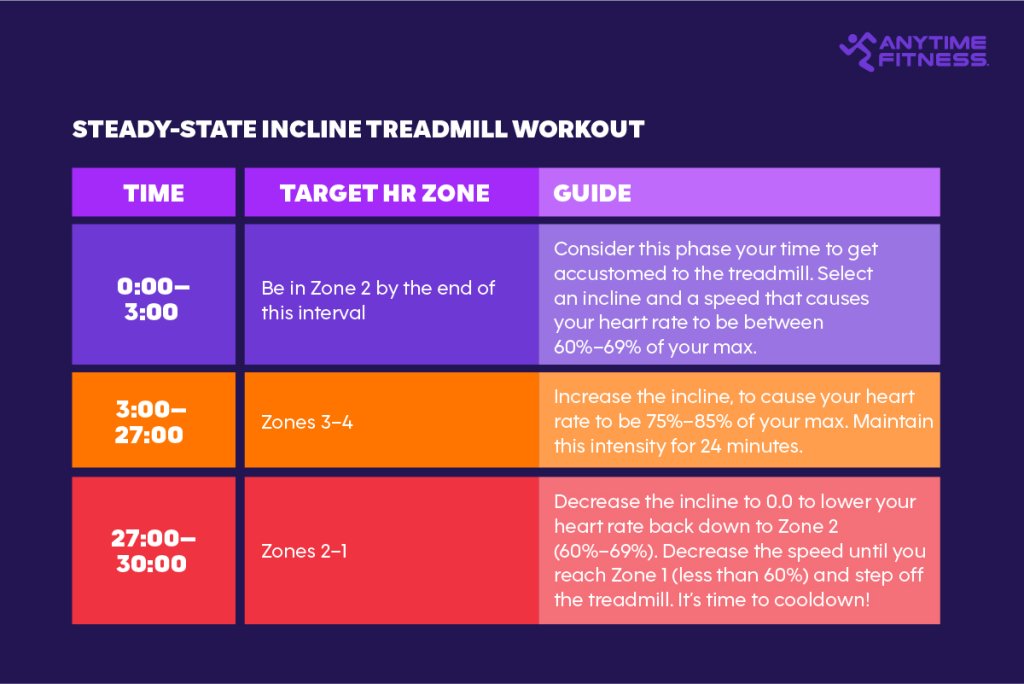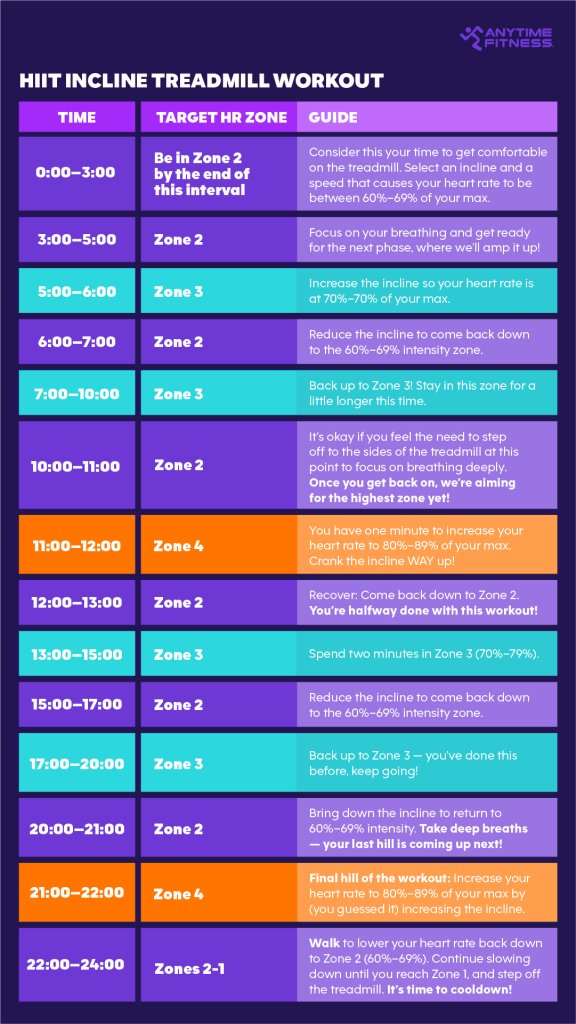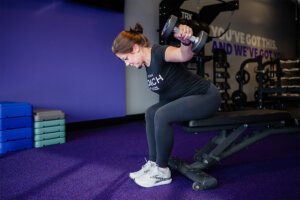Incline treadmill workouts have been wildly popular in recent years, thanks in part to the 12-3-30 workout trend that first appeared on YouTube in 2019. (ICYMI: This viral treadmill routine involves setting your treadmill to an incline of 12 and speed to 3 miles per hour and walking for 30 minutes.)
Read on to explore the hype and health benefits behind the incline treadmill workout routine. Then, give our expert-designed incline workout a go to experience the benefits firsthand.
What is an incline treadmill workout?
There are many incline treadmill workouts, including the popular 12-3-30 routine. They vary in structure, but as the name suggests, this treadmill routine generally involves walking, jogging, or running on a treadmill that’s set to an incline.
The amount of treadmill incline (known as the grade) is measured in percentages. When the treadmill is flat, it has a 0% incline. Most treadmills increase 1% at a time, topping out at 12% or 15%.
“An incline treadmill workout can serve as a great source of steady-state cardio and can even be modified to serve as a HIIT workout,” says AF Coach Heather Anderson.
Is it better to walk longer or on an incline?
When it comes to workout options, what is “better” for one person might not be “better” for another. Some prefer to do shorter, more intense workouts and others prefer to have a longer, less intense workout. There are benefits to both ways of working out, so do what you enjoy more, and feel free to change it up!
Are incline treadmill workouts effective?
Incline treadmill workouts are a great way to take your cardio up a notch to boost your fitness. “They’re effective because they demand more of the leg muscles and the cardiovascular system than walking with no incline,” explains Coach Heather. “This means your body burns more calories and gets the health benefits of a higher-intensity workout.”
Other benefits of high-intensity workouts include:
- Increased heart rate: Walking or running on a flat surface will raise your heart rate. But when you bump up the surface incline, your heart rate will soar even if your pace stays the same. One study on runners found that jogging at a 0% incline led to an average heart rate of 148 beats per minute (bpm). That went up to 155 bpm with a 2% increase in incline and 170 bpm at a 7% incline. The runners stuck to the same speed the entire time.
Reaching higher heart rates during your workout trains your heart to pump blood more efficiently, so your heart pumps more blood with every beat, per the National Heart, Lung, and Blood Institute.
“An incline treadmill workout is especially effective when paired with a heart-rate monitor or smartwatch, because you can fine-tune your intensity to meet your goals,” says Coach Heather. - Boosted VO2 max: Also known as maximum oxygen consumption, VO2 max refers to the maximum amount of oxygen your body can take in and use during exercise. It’s a good tool to measure cardiorespiratory fitness and endurance.
- Lower impact than regular running: Walking or running at an incline can also help with impact on the body, as it has the added benefit of building cardiorespiratory fitness and health without pounding the joints to the same extent as walking or running over flat ground.
Research shows that climbing an incline reduces the angle between the knee and ankle when the knee moves away from the body, as when stepping forward. Landing your foot on the ground with a shorter angle between the knee and ankle may lower your knee pain and injury risk, making incline treadmill workouts a great option for those trying to reduce the impact on their joints.

While you can see health and fitness benefits that come from walking or running on hilly outdoor routes, taking your incline workout to the treadmill gives you greater control over your intensity. Gasping for air? Drop the incline a touch or pause the treadmill belt. Barely breaking a sweat? Bump up the incline until you feel the sweat beads forming.
Are incline treadmill workouts good for losing weight?
“Incline treadmill workouts are helpful for those with a weight-loss goal, especially when paired with a balanced diet, ample hydration, and a thoughtful recovery plan,” says Coach Heather.
In fact, a study of 16 people found that compared to walking on flat ground, the calorie burn of walking increased by 17% at a 5% incline and 32% at a 10% incline.
Put another way: Let’s say a 150-pound person might burn around 180 calories walking at a 1%–5% incline for 30 minutes at a pace of 3.5 miles per hour (per estimates from Harvard Medical School). If you maintain that pace for the same number of minutes but increase the incline to 6%–12%, your burn jumps to 272 calories.
“Incline treadmill workouts are great for building lean muscle mass in the lower body,” says Coach Heather. “The more lean muscle mass one has, the higher the metabolism and the higher the rate of calorie burn while at rest.”
How many calories does an incline treadmill workout burn?
The total number of calories burned during an incline treadmill workout will vary depending on a number of factors, like your gender, body composition, and overall level of fitness. But generally, “you can expect to burn from 200–700 calories per hour during an incline treadmill workout,” says Coach Heather. “The best way to get an accurate estimate is to wear a fitness tracker or heart rate monitor that uses your biometric information — such as age and weight — to calculate your calories burned.”
But remember: Exercise is only part of the weight-loss puzzle. The other part is a healthy, balanced diet.
What muscles does an incline treadmill workout work?
An incline workout of any kind — walking and jogging — recruits most of your body’s muscles, particularly the lower-body muscles. But as the incline steepens, more of the work shifts to your quadriceps (the muscles in the front of your thigh) and glutes (the buttock muscle), per Texas Health. You’ll also feel a greater burn in your calf muscles. Overall, incline walking or jogging targets:
- Glutes
- Quads
- Hamstrings
- Calves
- Core
Incline Treadmill Workout — 2 Ways
There are two ways we’ll approach this incline treadmill workout based on the type of workout you’re looking for: steady-state workout and HIIT workout.
Incline Treadmill Workout 1: Steady State
If you’re doing a steady-state workout where you are at the same speed and incline level throughout, aim to be in the 75%–85% of your heart rate max for the majority of your workout (more on measuring your max heart rate here). Here’s a good steady-state incline treadmill workout to try that’s only 30 minutes:

Incline Treadmill Workout 2: HIIT
If your goal is to get a HIIT workout with short bursts of intensity, alternate between the 60%–69% zone (your recovery zone) and 80%–89% zone (your working zone). Here are 24 minutes of incline treadmill intervals aimed at toning up and losing weight:

A final word on incline treadmill workouts
There’s plenty to love about incline treadmill workouts — from the health and fitness benefits to the fast-turn burn — but they’re not for everyone. For instance, incline treadmill workouts may be too intense if you’re new to exercise or returning after a break. You may want to spend a few weeks getting used to walking or jogging on relatively flat surfaces before adding the challenge of an incline.
In addition, some people prefer exercising outdoors over walking or running indoors. If being outside in natural surroundings is more enjoyable for you (nature can have a big impact on your health!), look for hilly walking and running routes to get the benefits of an incline workout without a treadmill.
Want more workouts like this one?
We got you covered when it comes to both low- and high-impact workouts that help improve your health, endurance, and overall fitness. Here are just a few:
Book a free Anytime Fitness trial now for access to Coaches, group training sessions, and tons of free workouts on the Anytime Fitness App.



